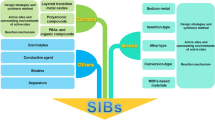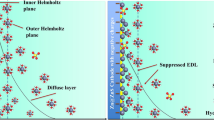Abstract
The oxidation of a 10 mM aqueous solution of sodium bromide in a sulfuric acid medium on the surface of a platinum electrode in a cell with separated spaces was studied. The process is important in view of the use of the bromine–bromide redox couple in redox flow batteries. The study was performed by cyclic voltammetry, potentiostatic chronoamperometry with optical absorption spectrum recording, and measurements of the potential of the redox reference electrode. A numerical procedure for processing the experimental spectra of the solution was developed to separate them into the spectrum of molecular bromine and the residual signal. The latter was attributed to the absorption of the tribromide anion based on the literature data. The experimental dependences of the Br2 and Br3- concentrations for the oxidative electrolysis of the NaBr solution in the sulfuric acid medium agreed well with the theoretical predictions. The current efficiency of bromine formation was evaluated.
Similar content being viewed by others
References
Alaee, M., et al., An overview of commercially used brominated flame retardants, their applications, their use patterns in different countries/regions and possible modes of release, Environ. Int., 2003, vol. 29, no. 6, pp. 683–689.
Ristaino, J.B. and Thomas, W., Agriculture, methyl bromide, and the ozone hole: can we fill the gaps?, Plant Dis., 1997, vol. 81, no. 9, pp. 964–977.
Jenner, H.A., et al., Cooling water management in European power stations: biology and control of fouling, Paris: Electricite de France, 1998.
Tolmachev, Y.V., Hydrogen-halogen electrochemical cells: a review of applications and technologies, Russ. J. Electrochem., 2014, vol. 50, no. 4, pp. 301–316.
Cho, K.T., Tucker, M.C., and Weber, A.Z., A review of hydrogen/halogen flow cells, Energy Technol., 2016, vol. 4, no. 6, pp. 655–678.
Tolmachev, Y.V., et al., Energy cycle based on a high specific energy aqueous flow battery and its potential use for fully electric vehicles and for direct solar-tochemical energy conversion, J. Solid State Electrochem., 2015, vol. 19, no. 9, pp. 2711–2722.
Vorotyntsev, M.A., Konev, D.V., and Tolmachev, Y.V., Electroreduction of halogen oxoanions via autocatalytic redox mediation by halide anions: novel EC" mechanism. Theory for stationary 1D regime, Electrochim. Acta, 2015, vol. 173, pp. 779–795.
Modestov, A.D., et al., A Hydrogen-Bromate Flow Battery for Air-Deficient Environments, Energy Technol., 2018, vol. 6, no. 2, pp. 242–245.
Kelsall, G.H., Welham, N.J., and Diaz, M.A., Thermodynamics of Cl–H2O, Br–H2O, I–H2O, Au–Cl–H2O, Au–Br–H2O and Au–I–H2O systems at 298K, J. Electroanal. Chem., 1993, vol. 361, nos. 1–2, pp. 13–24.
Huang, X., Gao, N., and Deng, Y., Bromate ion formation in dark chlorination and ultraviolet/chlorination processes for bromide-containing water, J. Environ. Sci., 2008, vol. 20, no. 2, pp. 246–251.
Fang, J., et al., Bromate formation from the oxidation of bromide in the UV/chlorine process with low pressure and medium pressure UV lamps, Chemosphere, 2017, vol. 183, pp. 582–588.
Von Gunten, U. and Oliveras, Y., Advanced oxidation of bromide-containing waters: bromate formation mechanisms, Environ. Sci. Technol., 1998, vol. 32, no. 1, pp. 63–70.
Ferro, S., The bromine electrode part III: reaction kinetics at highly boron-doped diamond electrodes, J. Appl. Electrochem., 2005, vol. 35, no. 3, pp. 279–283.
Bergmann, M.E.H., Iourtchouk, T., and Rollin, J., The occurrence of bromate and perbromate on BDD anodes during electrolysis of aqueous systems containing bromide: first systematic experimental studies, J. Appl. Electrochem., 2011, vol. 41, no. 9, p. C. 1109.
Osuga, T. and Sugino, K., Electrolytic production of bromates, J. Electrochem. Soc., 1957, vol. 104, no. 7, pp. 448–451.
Vacca, A., et al., On the formation of bromate and chlorate ions during electrolysis with boron doped diamond anode for seawater treatment, J. Chem. Technol. Biotechnol., 2013, vol. 88, no. 12, pp. 2244–2251.
Cettou, P., Robertson, P.M., and Ibl, N., On the electrolysis of aqueous bromide solutions to bromate, Electrochim. Acta, 1984, vol. 29, no. 7, pp. 875–885.
Pavlović, O.ŽZ., Krstajić, N.V., and Spasojević, M.D., Formation of bromates at a RuO2TiO2 titanium anode, Surf. Coat. Technol., 1988, vol. 34, no. 2, pp. 177–183.
Conway, B.E., Phillips, Y., and Qian, S.Y., Surface electrochemistry and kinetics of anodic bromine formation at platinum, J. Chem. Soc., Faraday Trans., 1995, vol. 91, no. 2, pp. 283–293.
Ferro, S. and De Battisti, A., The bromine electrode. part i: adsorption phenomena at polycrystalline platinum electrodes, J. Appl. Electrochem., 2004, vol. 34, no. 10, pp. 981–987.
Ferro, S., Orsan, C., and De Battisti, A., The bromine electrode. Part II: reaction kinetics at polycrystalline Pt, J. Appl. Electrochem., 2005, vol. 35, no. 3, pp. 273–278.
Xu, J., Georgescu, N.S., and Scherson, D.A., The oxidation of bromide on platinum electrodes in aqueous acidic solutions: electrochemical and in situ spectroscopic studies, J. Electrochem. Soc., 2014, vol. 161, no. 6, pp. H392–H398.
Kshirsagar, G. and Field, R.J., A kinetic and thermodynamic study of component processes in the equilibrium 5HOBr = 2Br2 + + 2H2O + H+, J. Phys. Chem., 1988, vol. 92, no. 25, pp. 7074–7079.
Chang, J., Bennett, B., and Bard, A.J., Detection of an unstable intermediate in Br–electro-oxidation to Br3–on a platinum electrode in nitrobenzene by scanning electrochemical microscopy, Electrochim. Acta, 2017, vol. 238, pp. 74–80.
Allen, G.D., et al., A mechanistic study of the electrooxidation of bromide in acetonitrile and the room temperature ionic liquid, 1-butyl-3-methylimidazolium bis(trifluoromethylsulfonyl) imide at platinum electrodes, J. Electroanal. Chem., 2005, vol. 575, no. 2, pp. 311–320.
Konev, D.V., et al., In situ UV-visible spectroelectrochemistry in the course of oxidative monomer electrolysis, Electrochim. Acta, 2015, vol. 179, pp. 315–325.
Michalowski, T., Calculation of pH and potential E for bromine aqueous solution, J. Chem. Educ., 1994, vol. 71, no. 7, p. 560.
Clavilier, J., et al., Preparation of monocrystalline Pt microelectrodes and electrochemical study of the plane surfaces cut in the direction of the 111 and 110 planes, J. Electroanal. Chem. Interfacial Electrochem., 1980, vol. 107, no. 1, pp. 205–209.
Johnson, D.C. and Bruckenstein, S., A Ring-Disk Study of HOBr formation at platinum electrodes in 1.0M H2SO4, J. Electrochem. Soc., 1970, vol. 117, no. 4, pp. 460–467.
Beckwith, R.C., Characteristics of aqueous bromine and hypobromous acid and the kinetics and mechanism of the reaction of bromine and hydroxylamine, 1997.
Beckwith, R.C. and Margerum, D.W., Kinetics of hypobromous acid disproportionation, Inorg. Chem., 1997, vol. 36, no. 17, pp. 3754–3760.
Betts, R.H. and Mackenzie, A.N., Formation and stability of hypobromous acid in perchloric acid solutions of bromine and bromate ions, Can. J. Chem., 1951, vol. 29, no. 8, pp. 666–677.
Citri, O. and Epstein, I.R., Systematic design of chemical oscillators. 43. Mechanistic study of a coupled chemical oscillator: the bromate-chlorite-iodide reaction, J. Phys. Chem., 1988, vol. 92, no. 7, pp. 1865–1871.
Bard, A.J., Standard Potentials in Aqueous Solution, Routledge, 2017.
Griffith, R.O., McKeown, A., and Winn, A.G., The bromine-bromide-tribromide equilibrium, Trans. Faraday Soc., 1932, vol. 28, pp. 101–107.
Liebhafsky, H.A., The equilibrium constant of the bromine hydrolysis and its variation with temperature, J. Am. Chem. Soc., 1934, vol. 56, no. 7, pp. 1500–1505.
Author information
Authors and Affiliations
Corresponding author
Additional information
Original Russian Text © M.M. Petrov, P.A. Loktionov, D.V. Konev, A.E. Antipov, E.A. Astafiev, M.A. Vorotyntsev, 2019, published in Elektrokhimiya, 2019, Vol. 55, No. 1, pp. 95–105.
Rights and permissions
About this article
Cite this article
Petrov, M.M., Loktionov, P.A., Konev, D.V. et al. Evolution of Anolyte Composition in the Oxidative Electrolysis of Sodium Bromide in a Sulfuric Acid Medium. Russ J Electrochem 54, 1233–1242 (2018). https://doi.org/10.1134/S1023193518130335
Received:
Accepted:
Published:
Issue Date:
DOI: https://doi.org/10.1134/S1023193518130335




